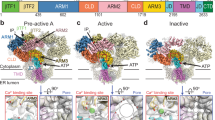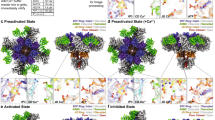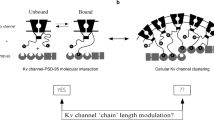Abstract
Arising from T. Rahman, A. Skupin, M. Falcke & C. W. Taylor Nature 458, 655–659 (2009)10.1038/nature07763
The inositol trisphosphate receptor (InsP3R) forms a calcium channel that resides in the membrane of the endoplasmic reticulum and is activated by inositol trisphosphate (InsP3). InsP3 is a phosphorylated monosaccharide that is generated via hydrolysis of phosphatidylinositol 4,5-bisphosphate (PIP2), a phospholipid that is located in the plasma membrane, and activation of the InsP3R is involved in a broad range of biological processes, including cell division, apoptosis and development. Rahman et al.1,2 reported that exposure to low concentrations of InsP3 induces rapid clustering of InsP3R Ca2+ release channels normally randomly distributed in endoplasmic reticulum/outer nuclear membranes. Importantly, clustered channels gate differently from lone channels. Using similar protocols, we observed InsP3R channel clustering without exposure to InsP3 (Fig. 1a), as we found in other systems3,4,5 with protocols designed to avoid InsP3 pre-exposure. More significantly, we find that clustering has no effect on InsP3R channel gating. For this reason, we believe that InsP3-induced channel clustering and modification of channel gating by clustering may not be universal phenomena.
This is a preview of subscription content, access via your institution
Access options
Subscribe to this journal
Receive 51 print issues and online access
$199.00 per year
only $3.90 per issue
Buy this article
- Purchase on Springer Link
- Instant access to full article PDF
Prices may be subject to local taxes which are calculated during checkout


Similar content being viewed by others
References
Rahman, T. U., Skupin, A., Falcke, M. & Taylor, C. W. Clustering of InsP3 receptors by InsP3 retunes their regulation by InsP3 and Ca2+ . Nature 458, 655–659 (2009)
Rahman, T. & Taylor, C. W. Dynamic regulation of IP3 receptor clustering and activity by IP3 . Channels (Austin) 3, 226–232 (2009)
Mak, D.-O. D. & Foskett, J. K. Single-channel kinetics, inactivation, and spatial distribution of inositol trisphosphate (IP3) receptors in Xenopus oocyte nucleus. J. Gen. Physiol. 109, 571–587 (1997)
Mak, D.-O. D. et al. Single-channel properties in endoplasmic reticulum membrane of recombinant type 3 inositol trisphosphate receptor. J. Gen. Physiol. 115, 241–256 (2000)
Ionescu, L. et al. Graded recruitment and inactivation of single InsP3 receptor Ca2+-release channels: implications for quantal Ca2+ release. J. Physiol. (Lond.) 573, 645–662 (2006)
Mak, D.-O. D., McBride, S. & Foskett, J. K. Regulation by Ca2+ and inositol 1,4,5-trisphosphate (InsP3) of single recombinant type 3 InsP3 receptor channels. Ca2+ activation uniquely distinguishes types 1 and 3 InsP3 receptors. J. Gen. Physiol. 117, 435–446 (2001)
Mak, D.-O. D., McBride, S. & Foskett, J. K. Inositol 1,4,5-trisphosphate activation of inositol trisphosphate receptor Ca2+ channel by ligand tuning of Ca2+ inhibition. Proc. Natl Acad. Sci. USA 95, 15821–15825 (1998)
Vais, H. et al. Redox-regulated heterogeneous thresholds for ligand recruitment among InsP3R Ca2+ release channels. Biophys. J. 99, 407–416 (2010)
Kenyon, J. L. & Bauer, R. J. Amplitude histograms can identify positively but not negatively coupled channels. J. Neurosci. Methods 96, 105–111 (2000)
Author information
Authors and Affiliations
Contributions
All authors contributed to project planning and wrote the paper. H.V. and D.-O.D.M. did data acquisition and analysis.
Corresponding author
Ethics declarations
Competing interests
Competing financial interests: declared none.
PowerPoint slides
Rights and permissions
About this article
Cite this article
Vais, H., Foskett, J. & Mak, DO. InsP3R channel gating altered by clustering?. Nature 478, E1–E2 (2011). https://doi.org/10.1038/nature10493
Received:
Accepted:
Published:
Issue Date:
DOI: https://doi.org/10.1038/nature10493
This article is cited by
-
Rahman et al. reply
Nature (2011)
Comments
By submitting a comment you agree to abide by our Terms and Community Guidelines. If you find something abusive or that does not comply with our terms or guidelines please flag it as inappropriate.



